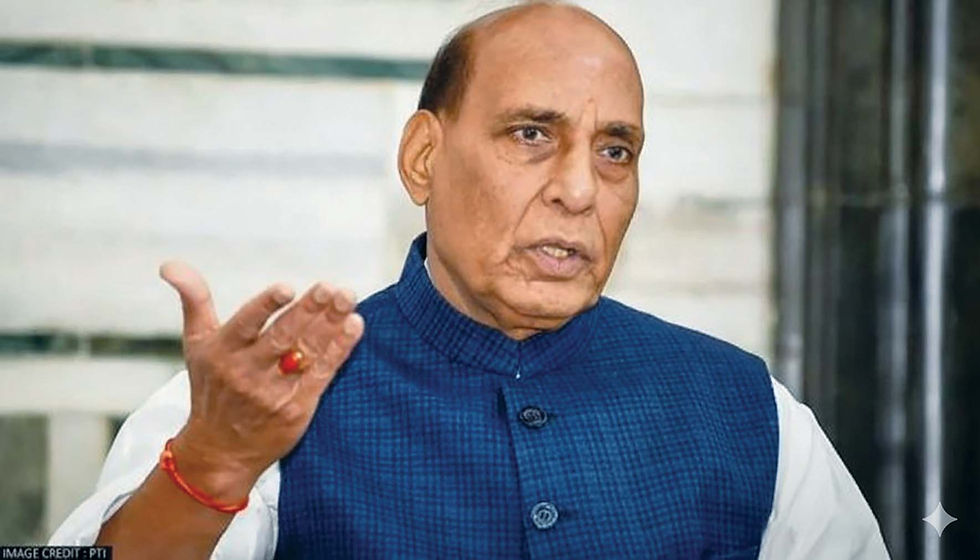Marching Into Battle: Can Gender Equality Withstand the Reality of Combat?
- Brigadier AS Ranade, VSM (Retired)

- May 26
- 5 min read
The National Defence Academy (NDA) is poised to witness a historic milestone. On May 30, its first cohort of 18 women cadets will graduate - a moment made possible by the Court’s landmark 2021 ruling mandating gender-inclusive reforms in the military. Their induction comes at a time when the quest for gender parity in combat roles collides with the unforgiving demands of modern warfare, prompting difficult questions about merit, equality and operational readiness. In the first of a two-part series, we examine the evolving role of women in India’s armed forces as the Supreme Court reconsiders permanent commissions for female officers.
PARTI - 1
As wars across the globe return to their brutal basics, the debate over gender in combat must confront the hard truths of biology, not just the ideals of equality.

I pen my thoughts in the backdrop of two protracted wars raging in the globe today. The one between Russia and Ukraine since February 2022, whose repercussions are being felt across the world, and the other between Israel and Hamas in the killing fields of Gaza since October 2023, which has ratcheted tensions across the entire Middle East and beyond. These conflicts have made the world sit up, take notice and dump the idea that modern wars can be short and swift.
Despite the use of state-of-art technologies including remotely controlled weapons, hi-tech drones and surveillance equipment which can be handled with soft touches from digitized consoles, the need for boots on ground has far from diminished. Social media is flooded with videos of violent close combat, sometimes hand to hand, and soldiers roughing it out in battle zones for weeks and months with little administrative support and abysmal personal hygiene, in extremely harsh weather to control real estate. While warfare keeps getting modernized, holding territory remains critical to warfighting. And it is this sphere of combat which continues to remain very physical, violent, bloody and brutal in nature, takes a heavy toll on the human body and could be long drawn as these two conflicts have shown.
Russia is pitched against a ‘weaker’ adversary and yet it has been a war of attrition. The gains on ground over more than three years have been incremental at best, requiring hard fought, physical, violent and bloody no-holds barred battle after battle to seize territory. Israel is pitched against an even ‘weaker’ enemy and yet the fighting through the built-up areas has been gruesome, despite disproportionate use of air power to weaken the opposition before launch of physical assault by infantry, armour and mechanized infantry. These operations too have been physically demanding, requiring tremendous strength, endurance, stamina and mental robustness, draining the soldiers of every ounce of their reserves.
In the Indian context, we have fought wars in very trying conditions in extreme high altitude and snow, glaciated terrain, treacherous deserts and riverine and jungle terrain. The tactical battlefield areas in these wars demanded supreme physical and mental robustness for weeks and months to survive and to eliminate enemy threat in violent and bloody battles.
Recently, the barbaric massacre of 26 tourists on 22 April at Pahalgam orchestrated by the Pakistani Deep State forced India into a punitive retaliation in the form of Operation Sindoor between May 7 and May 10. The four-day conflict which was primarily an air and air defence conflagration could have pushed the ground combat forces on either side into a bloody war.
We continue to be deployed astride a 776 km. long Line of Control (LoC) on our western borders under trying circumstances and astride a treacherous 3488 kms long Line of Actual Control (LAC) on our northern borders. Combat units are deployed for a duration of two-three years to occupy posts and guard against the nefarious designs of our adversaries. Laying ambushes, patrolling, reconnaissance and surveillance are bread and butter for these units during such deployments. We continue to be engaged in counter infiltration and counter terrorism operations in Kashmir and counter insurgency operations in the North-east. To state the obvious, these operations are extremely demanding on the human body.
It is evident that combat zones for the Army both in conventional and sub-conventional domains demand supreme physical fitness and mental robustness. And to train for war which is central to a soldiers’ peace time activities therefore demands an equal amount of physical effort for weeks and months, year on year without any compromise. It emerges unambiguously that even in modern times, warfare and combat would remain violent, physical, bloody and unforgiving with only the supremely fit surviving the tirade of the adversary, adverse weather and abysmal living conditions.
We cannot change the physiological reality that men and women are differently endowed. If that be so, the question that arises is whether our nation should promote gender equality while enrolling its officers and soldiers in combat roles or accept gender reality, taking a pragmatic and rational approach on the subject in the best interest of our National Security.
To draw an analogy, let us look at sports as another profession which is physically and mentally demanding. Have you ever wondered as to why we do not talk of gender equality in sports?
Why do we need to have separate events for men and women? In fact, even within the same gender boxing and wrestling have different weight categories. Why don’t we allow a heavyweight to wrestle or box against a lightweight? Is it unfair to women who are not allowed to compete against men or to be part of men’s teams and the lightweights who are not allowed to compete against the heavier opponents of the same gender? Why have not sports shifted to gender neutrality? Why only equestrian events like show jumping and dressage gender neutral? The answer is simple.
It is due to the differences in physiology which have a profound effect on physical performance of athletes and the outcome in sports, barring a few equestrian events where the physiological differences between men and women do not have any effect.
A number of friendly matches touted as ‘battle of the sexes’ has been played over the years between famous female tennis players against male opponents who were much lower in the ATP rankings with handicaps given to female players to offset their physiological disadvantage. The male tennis players emerged victorious every time in mostly one-sided matches. The credo of the Olympic games is ‘Citius, Altius, Fortius’ meaning ‘Faster, Higher, Stronger.’
No female athletes have been able to go faster, higher or be stronger than the best the men could achieve. Men and women are just differently endowed physiologically and it will show in any activity which requires use of physical strength, endurance, stamina and power including military combat. To get a correct perspective, let us compare the world records for men and women 5000 metres track race event. The fastest male athlete clocks 12 mins and 35 secs while the fastest female athlete clocks 14 minutes. The difference is 85 seconds translating to a staggering 561 metres lead in a 5000 metres race. There is absolutely no competition between the two.
The difference is similar for all other events as well and the reasons are obvious. The high jump world record for men is 35 centimetres higher than the best female athlete, the male long jump world record is 1.43 metres longer than the best female long jumper and the best javelin throw by a male is 26.20 metres farther than his female counterpart. The differences in the physical performance due to inherent physiological differences between the two sexes are starkly prominent. One would do well to keep in mind that when speed, height and strength are the measure, it is biology and not ideology that draws the finish line.
(The writer is an Indian Army veteran and Vice President CRM, ANSEC HR Services Ltd. He is a skydiver and a specialist in Security and Risk Management. Views personal.)





Comments